Torque Talk...
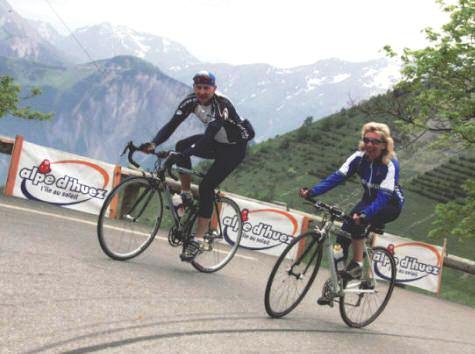
stay seated and torque that gear
mr and mrs flamme
rouge on holiday
First, the caveat and disclaimer...
This is a VERY cut down version of the science and maths around a very complex subject. So I don't want a load of emails from the "Sheldon Coopers" of the world saying I've over-simplified it! This article is to help normal people understand a non-normal subject. It's not here to gain a Nobel Science award or a Wurlitzer Prize for Literature!
All I'm offering is the truth; nothing more...
Torque Talk
If you ride a bike, there will be torque, it's
in loads of places and performs loads of functions. The torque we are interested in today, is the "turning force" you apply to the pedals to propel you bicyclette.
The equation and relationship is quite simple; no torque, no propulsion; no propulsion, no speed; no speed, no victory; no victory, no glory.
Which means, torque is really important; and probably a lot more really important than many people really realise.
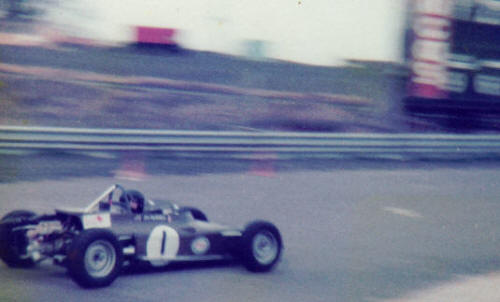
Me in 1977 ~ I was 17 and lied about my age, you had
to be 18
I forged a letter from my mum. I didn't even have a full
driving licence!
Before I slowly mooched around on bikes, as I now do, in the olden days, I rapidly mooched about in cars. Back then there was a great saying of "inconvenient truth" that "power sells engines, torque wins races".
Forty years later, I'm still pushing pedals (albeit different ones) and the premise still stands; for bikes as much as it ever did for cars. Everyone wants to know your (or more likely tell you about their) power output; no one ever talks about torque. But today we're going to change that.
So, off to the pedals and the important tourquey stuff. Sorry this is a bit long, but you should have seen what I left out...
Geeky Forces at Play
When you pedal your bike, there are two dynamics at play; how hard you press
on the pedals, and how fast you turn them. The two are
indelibly linked,
you can't have one without the other.
It's the endless "exclusively mutual" combination of these two parameters that determines how fast your bike goes, and the enigmatic, ethereal mix of physiological "physicality" used to propel it. Another dark art we'll also cover here...
Everything you do on a training ride, or race, is a constantly moving trade off between physical efficiency and physiological effectiveness. And most of it starts at the pedals.
Torque is measured in Newton meters, which means little to most people and not much more to me. Torque used to be measured in foot pounds; which, as a young engineer, I really could understand and relate to.
Visualise it as a one pound weight, hung off the end of a one foot long bar; there you have it, "one foot pound of torque".

thanks to AGCO Auto of Baton Rouge for the image...
But these days, it's all gone decimal. Now, it's Newton meters, which means hanging one Newton, from the end of a one meter long bar. A tadge harder to visualise, I would suspect?
As a defined unit, a Newton is the force required to accelerate one kilogram at the rate of one meter per second, per second. Which as luck would have it, is the speed of gravity. So all we need to do is lob a kilo out of a first floor window and measure it.
A quick bit of science...
A kilogramme falls (gravity) at 9.8 meters per second squared
Which, magically, makes a kilogramme equal to 9.8 newtons!
So, 1 newton is 1kg/9.80 = 0.102 kg or (102g) or (4 oz)
Which is the weight of a banana, or a bar of chocolate, hanging off the end of a meter long bar.
When your handlebar bolt says tighten to a torque to 4 Nm, this is the equivalent leverage of hanging the above one pound weight (4 x 4oz), off the end of the one metre long bar or, more likely, an allen key.
Fantastic! Now you've visualized it, we can look at how this helps us? So, stick with it a little longer please...
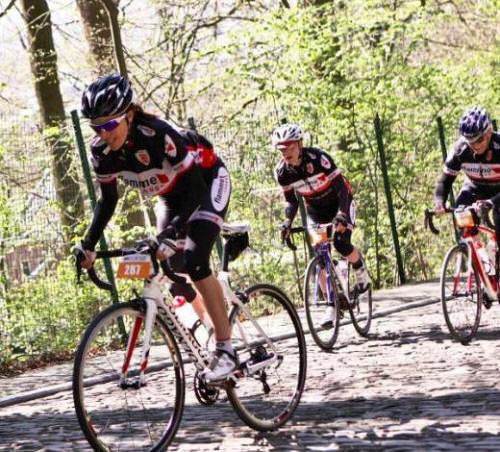
Susan Clark putting 490 newtons through her 172.5 SRM cranks
Pete Slattery & Simon Perchard
pushing slightly more!
Let's be really "generic" here and say we have your "average" female and male rider, weighing in at 55 and 70 kilos respectively.
When your average rider stands on a climb and hangs off the front of their bike, as shown here by our valiant trio on Flanders' iconic Muur de Gerrardsbergen, they have the potential to exert, through the pedals, a force of approximately...
539 N ~ for the 55 kilo Female (55kg x 9.80)
or
686 N ~ for the 70 kilo Male (70kg x 9.80)
But knowing the application of force, means little without knowing how fast it is being applied. A force on its own is not very powerful. Again a little (perceptual) audience participation is required...
Sit down, then take your hand and push down as hard as you possibly can on your knee. Nothing happens!
Now hold your hand above your head, and swing it as fast as you can on to the same said knee. I bet something happens now. Now you can literally "feel the force"...
Force is pretty useless unless it is moving. So now we (sort of) bring cadence in to it. Which is where it gets messy!
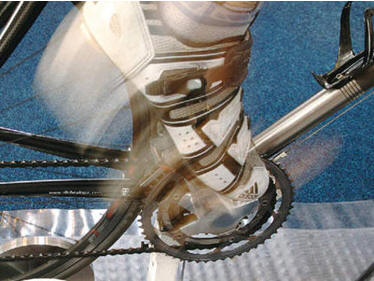
Bring on the Matrix...
As you all know, I do love a good chart, especially a matrix!
Fortunately, for this type of conundrum, a matrix is the perfect vehicle for
us to simply demonstrate what we complicatedly mean.
When you pedal, you choose from two levels of two options. You can turn your pedals anywhere between a very low speed and a very high speed; with the other option being of pushing on them very lightly or very heavily.
For each option, dependent on our current terrain, fatigue and gearing, we all instinctively choose a point on the horizontal (slow/fast) axis and the vertical (light/heavy) axis...
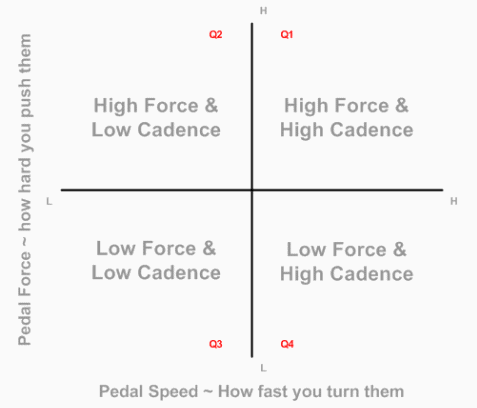
We are always pedalling at some point on this "relative spectrum". It's relative, because what you think is very fast (say 100 rpm) might be considered slow for a Keirin or BMX rider (220+ rpm). And what a 50 kilo riders considers a heavy push, might be a tickle for a 100 kilo rider!
But as you can see above we have four pedalling quadrants. Every pedal stroke you take, on every ride, will fall somewhere in that matrix, which (as explained above) is relative to you.

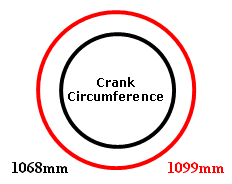 Power
Comes From Within
Power
Comes From Within
Power, which we measure in watts on our handlebar gizmos, is
a product of how hard you press on the pedals and how fast you
turn them.
We're not talking about cadence as such here, because a 175 mm crank travels further, hence faster, per rev than does a 170 mm crank.
What we measure in the context of torque and power is crank "speed".
Crank speed is measured in metres per second. If we know the length of our crank, and we know it's rpm, we can calculate the speed at which the pedal (and by definition your foot (that creates the force)) is travelling.
As you can see in the chart, a 175mm crank travels 1099 mm per rev, while a 170 mm crank travels 1068mm. Revs, times distance, equals speed. And once we know the speed of the crank and the force applied to it, we have the potential to calculate power!
The (simplified) formulae are...
force x crank length = Torque
torque x crank speed = Power
Once we have the power, we can use this to calculate or measure your Functional Threshold (40 minute) Power. It's this number that sets one of the "relativity" parameters of "your" matrix. The other is your "average pedal speed" for the effort.
It's these two parameters that form the centre "crosshairs" of the quadrant. Your FTP, at your average pedal speed, is always the dead centre of YOUR matrix.
It's these relative entities, and our ability to "centralise" them, that allows us to compare quadrants across differing builds of riders.
To place these forces in to a riding context, here's the same matrix, with some generic, but not exclusive, ride descriptors...

You can see that differing riding efforts will generally require differing pedalling techniques. You would not, for instance, do a one hour recovery ride by riding in Quadrant Two (upper-left) at 30 rpm in your 53x11.
And if you ain't in the far-top-right corner of Q1, pedalling as fast as you can, pushing for all you are worth in one of your biggest gears, you ain't gonna be winning no sprint!
So needs must. But for most of the time, in most situations, we will be hovering somewhere around that centre circle "comfort zone".
We normally only move to the outer edges of each quadrant, when a specific race or training scenario dictates.
How does this help me?
I hear someone ask, rhetorically. In more ways than you might
think. I reply, matter of factly.
I get loads of people asking "What's the best cadence...", as a preface to one of the following questions...
▼ to ride a time trail
▼ to climb a hill/mountain
▼ for efficiency
▼ for effectiveness
As with every answer I ever give, it starts with, "It depends...".
Cadence and power are often given more importance than they actually deserve. Apart from my constant mantra of "it's the person with the fastest leg speed that wins the race".
Which is true when all things are equal in a sprint. If everyone is in the same gear, sprinting for the same line, from the same spot, it's normally the one pedalling the fastest, at the line, that will take the win.
But what of a 10 mile TT, a 100 mile TT, a big Tourmalet-type climb, or a 180k sportive? What then? Well then, it comes down to torque.
When you change your cadence, you are not selecting it through some pre-conceived free will. Cadence is relative to the torque range you feel comfortable operating in. At any given moment you are choosing at what torque to ride at, not what cadence to pedal at.
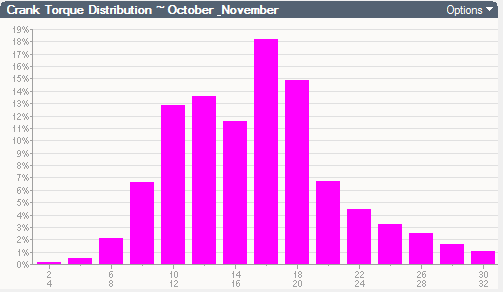
lady rider ~ torque generated through October & November training
Torque is Cheap...
Throughout our pre-training, training rides,
Slacktober and
Slowvember, it's all about riding aerobically, Zone Two, spinning
away, smelling the flowers. No effort, no fuss, no drama.
Just "normal" riding to develop the aerobic engine; "aerobicity" is
the bedrock of
everything you do.
Zone Two riding returns a torque distribution chart similar to the above. For this rider, left to their own devices, torque levels centered around a "comfort zone" of 14 to 20 Nm. Mainly around the lower semi-circle area of Quadrants 3 & 4.
But when we get to our Undulating Rides, normally in December, we ride slightly over geared (we don't want to tweak a back muscle or knee joint) to develop leg strength, core strength and build torque tolerance.
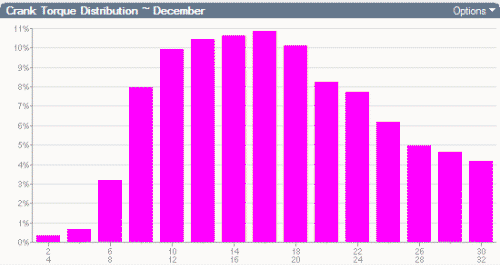
We're now in to Q2 (upper-left); low leg speed and applying high levels of force to the pedals. As you can see, the same riders' chart has now taken a very distinctive shift to the right.
It's a leg stinger, and most definitely taken them out of their comfort zone, that's for sure. Which, as I've said before, is one of the main roles of a good coach; to get you to do stuff you wouldn't choose to do if left to your own devices.
What I am encouraging riders to do here, is make that cross-hair centre circle bigger. The bigger that circle is, the greater your range is in each gear when the hammer goes down.
Some people scoff at our rides, because "they aren't fast enough". But when you look at the disproportionate force, relative to speed, being applied through our pedals, you can see that this takes our torque production to the next level.
This is the level of effort that, when the time is right, will bring speed of which others can only dream. A quick look at our Wall of Champions is living testimony to the hard work, endevour, and application of torque, from flamme rougers around the world.
And this is "free stuff". You're going to be on your bike anyway, so instead of trying to "race the climbs" in the winter, and fail, why not ride them slow and prepare to succeed?
Spend longer on the climb to maximise your training time and torque development. Which is a pre-cursor and enabler for the speed to come when the time is right. How can it not be?
How can training your body to consistently, and comfortably, have the ability to "press harder on the pedals" not make you a faster biker rider?
Many riders try to impress their friends with how many winter kilometres they've ridden, how many hours they've spent in the saddle or how fast the average speed of their rides are. For them, it's all about the quantity.
Here's my tip of the day; forget the quantity. Do less kilometres and do less hours but when you do them, do them harder and of a higher quality.
It's not a difficult or expensive choice to make. It's free speed.
Turning Torque in to Speed
In January we carry this new-found leg strength in to our Climbageddon
circuits (horizontal borders of Q2 & Q1); high force, medium leg speed.
As February arrives we consolidate our (now ingrained) strengths with the Q1 high leg speed sprints and drills of the Classics Circuits.
And in March, just as the season starts, we give it large with our (vertical border skimming Q1 & Q4) Speedfest Sessions; longer intervals with medium force, high leg speed.
But remember this, after undertaking specific torque drills in December and January, to shift our pedalling spectrum to the right, our "medium force" is now the equivalent to a non-torque-trained riders' "high" force. As I said earlier, it's all "relative".
Having realigned our body's expectations, we have increased our torque delivery (effectiveness) for the same physiological cost (efficiency).
A rider with a lower torque spread will have to pedal faster, or change up a gear, to keep with you. Either way, they will find themselves "out of their comfort zone" in a race situation. Which rarely ends well for them...
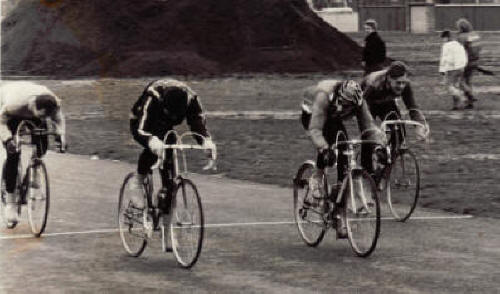
Q1 Quennevais Circuit Sprint Training 1986 ~ before helmet hair was
invented
me far left
getting aero (this is the start line not the finish!)
Use The Matrix
To summarise.
For our winter weekend rides, we travel around the
matrix building strength and power as we go. Slacktober is
"predominantly" in the circle area of Q3.
Slowvember is in the circle area of Q4.
Climbageddons are in the mid to upper right quadrant of Q2, outside the circle! And the Classics Circuits are in the mid to upper left of the outer area of Q1.
Finally, just before our season starts, we carry out our speed work, which concentrates on extended periods at the bleeding edge of quadrant one's circle. Then, with the season arrival, the "full-on" sprint work starts and we move to the top right corner of Q1.
The following information explains why this is really important. Your power output is undoubtedly important, it is after all what we are all trying to improve. But how that power is produced, and the physiological cost of producing it is even more important than the power itself.
Don't worry, we're nearly at the end.
Izzy Wizzy Lets Get Busy...
Okay, now it's time for the smoke and mirrors stuff. As I said
earlier, there's more to this pedalling lark than first appears.
But first, another (physiological) version of our matrix chart...
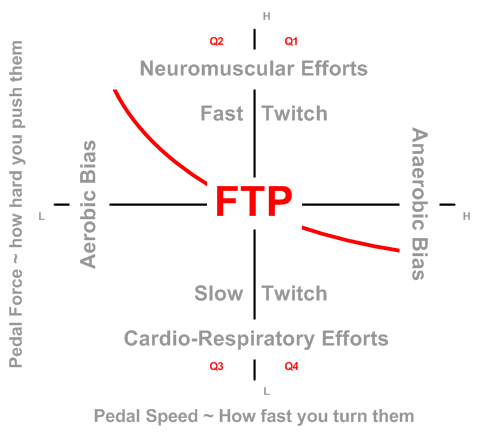
there's a log going on here, but it will all make sense shortly!
We can tell a lot from the way a rider pedals. And this graphic tries to capture most of it, without getting too clumsy. Although I do admit, it is a little busy! We'll start at the top and work down.
Upper Q1 & Q2 efforts are predominantly, fast-twitch muscle fibers and neuro-muscular centric. Which means the thighs, quads and glutes etc, contribute the most to your bicycle's propulsion.
Not exclusively remember, because everything we do is on a constant continuum. There is no lactate, aerobic, ventilatory threshold; ever! It's all one long sliding scale of performance.
 Work undertaken to the left of the matrix has a predominantly
aerobic (with-oxygen) bias, getting more anaerobic (without oxygen) as we move to the right.
Work undertaken to the left of the matrix has a predominantly
aerobic (with-oxygen) bias, getting more anaerobic (without oxygen) as we move to the right.
When you climb, pedalling slowly, at a muscular 300 watts, in a big gear, it's easy to keep your heart rate under control.
When you pedal quickly, still climbing at 300 watts, in a small gear, even though your power is exactly the same, the physiological demands are very different.
Your heart will beat quicker. There is now less of a muscular bias and a greater demand on your cardio-respiratory system (heart & lungs).
Lower Q3 & Q4 efforts have a greater cardio demand and make little demands on the muscles. Or the glycogen system. These efforts are mainly "fat-burner" fuel sourced.
Ironically, the faster you pedal the more use you make of your slow twitch muscle fibers. Sparing the (glycogen fuelled) fast ones for the race winning sprint.
This is why the pros do so much Zone Two (Q3 & Q4) work; they create a huge aerobic, glycogen sparing, slow-twitch predominant, extremely efficient engine that gets them to the end of the race.
They then smash the sprint with their "untouched", highly effective, glycogen rich, ATP fuelled, fast-twitch fibers, in an exclusively top right corner Q1, race winning crescendo.
But you have to be there at the end to win it. No fuel efficient, high-torque, aerobic-biased engine, no race winning sprint. You might win the sprint from the grupetto; but it's a pyrhric victory at best.
And as you can see, at the dominant centre of all this busy-ness, is your Functional Threshold Power.
Your FTP is the anchor, around which everything else pivots. Again, it's another slight misnomer, there is no "threshold" but it is a performance marker and the name has now gained traction.
Think of it more as "functional performance power". As you can see, it's central to everything you do.

deffo quadrant three as Pete Slattery tops the Muur
The Message
Okay, this page is long enough now, but there is more in-depth
stuff to this subject and how to make best use of the information it
provides, which will come next month.
For me, torque is a very misunderstood, often ignored, and now you can see, a very important part of your cycling armoury.
Torque development is the ugly duckling of the performance world. But it has the potential to turn you in to a swan.
We think we have a preferred cadence we like to ride at. But we don't, we have a preferred torque we like to push at. You just might not yet realize it. Retrain your body to produce and accept more torque, then pedal at the same cadence as before. Job done.
Do you think Tony Martin, Fabian Cancellara, Jens Voight and Bradley Wiggins think that torque isn't important?
These "masters of the breakaway", time trial specialists, and World Hour Record riders, all have one thing in common. Well two, if you count their huge oxygen uptake!
They all used their huge aerobic engine to "torque" the pedals around the full pedal stroke in a huge gear at a high cadence.
Your genetically set lung capacity is what it is; learn to accept it. But you can easily and quickly, develop your torque delivery; you can never have too much torque.
Torque is cheap but it's value is priceless.
As with The Matrix; you now have two options. You can take the (metaphorical) blue pill and keep doing the same things you've always done, and get the same results you've always got.
Or, as is the flamme rouge way, you can take the red pill, and the road less traveled for a journey in to wonderland.
All I'm offering, is the truth, nothing more. Why not visit the rabbit hole and go out to deliberately ride slow up a hill to make yourself stronger and faster. What have you got to lose?
Here's our specific session for torque development. A bit Ground Hog Day-ish and not the most dynamic of experiences, but boy does it work! Once a week for three weeks should see you right.
Have fun, keep safe, until we torque again...
PS: As an amusing aside, I've just invested in a Tacx Neo! How spooky...








